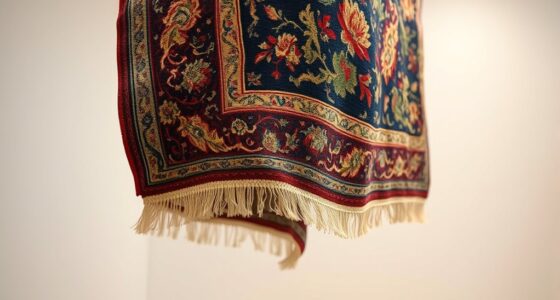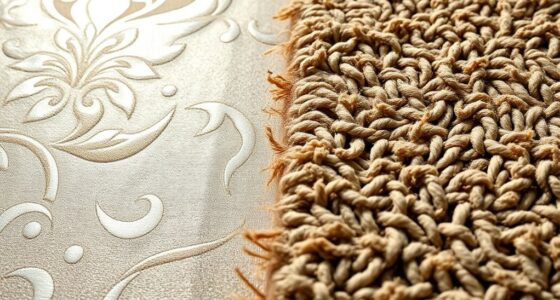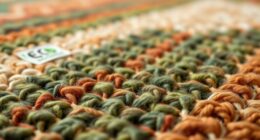To identify signature single-weaver masterpieces, look for distinctive design elements, motifs, and craftsmanship techniques that reflect the artist’s unique style and cultural roots. Examine weaving patterns, color choices, and subtle imperfections that showcase skill and authenticity. Pay attention to signature placement and any personal symbols. By appreciating these features, you can uncover genuine masterpieces. Keep exploring to discover more clues that help distinguish true signature works from imitations.
Key Takeaways
- Examine signature placement, consistency, and style compared to documented examples to verify authenticity.
- Analyze distinctive motifs, design elements, and cultural symbols unique to the artist or region.
- Assess weaving patterns, fiber materials, and construction techniques for craftsmanship indicators.
- Identify signature motifs, color palettes, and surface textures that reflect the artist’s signature style.
- Review provenance records and look for handcrafted imperfections that confirm authenticity and origin.
Recognizing Unique Design Elements and Motifs
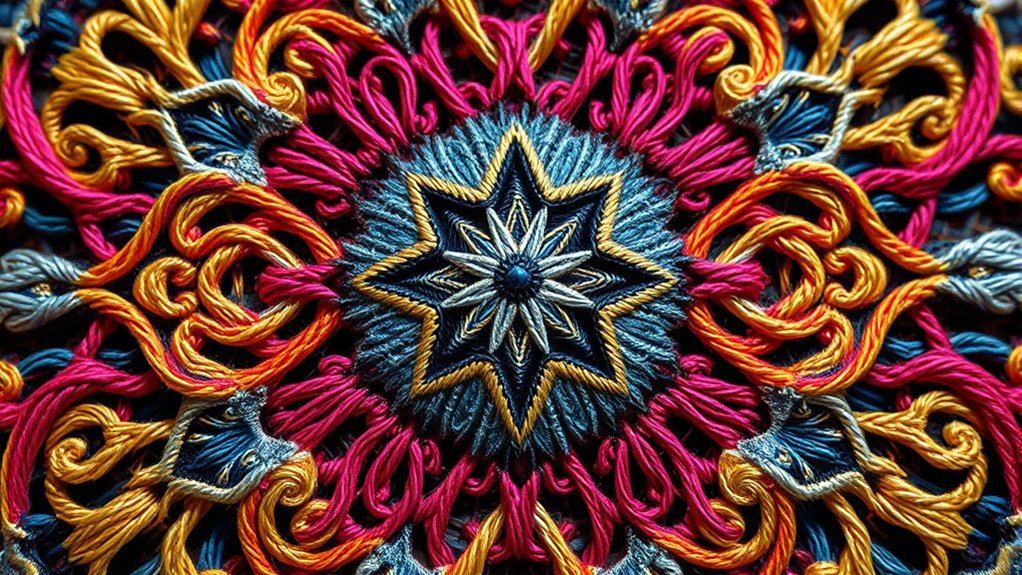
To truly appreciate single-weaver masterpieces, you need to learn how to recognize their distinctive design elements and motifs. These signature motifs often serve as the artist’s hallmark, revealing their personal style and cultural influences. Look closely at the patterns—are they symmetrical or asymmetrical? Do they feature specific symbols, floral designs, or geometric shapes? Consistent use of motifs across the piece demonstrates design consistency, which is essential in identifying authentic works. Pay attention to how motifs are repeated and integrated into the overall composition; this pattern recognition reflects the weaver’s skill and artistic vision. Recognizing these elements helps you distinguish a true masterpiece from imitations and deepens your appreciation of the craftsmanship behind each piece. Additionally, understanding the cultural context of the motifs can provide further insight into the origins and significance of the artwork. Exploring the subtle vibrational cues embedded in the design can also enhance your appreciation by connecting visual elements with energetic resonance.
Examining the Weaving Technique and Construction
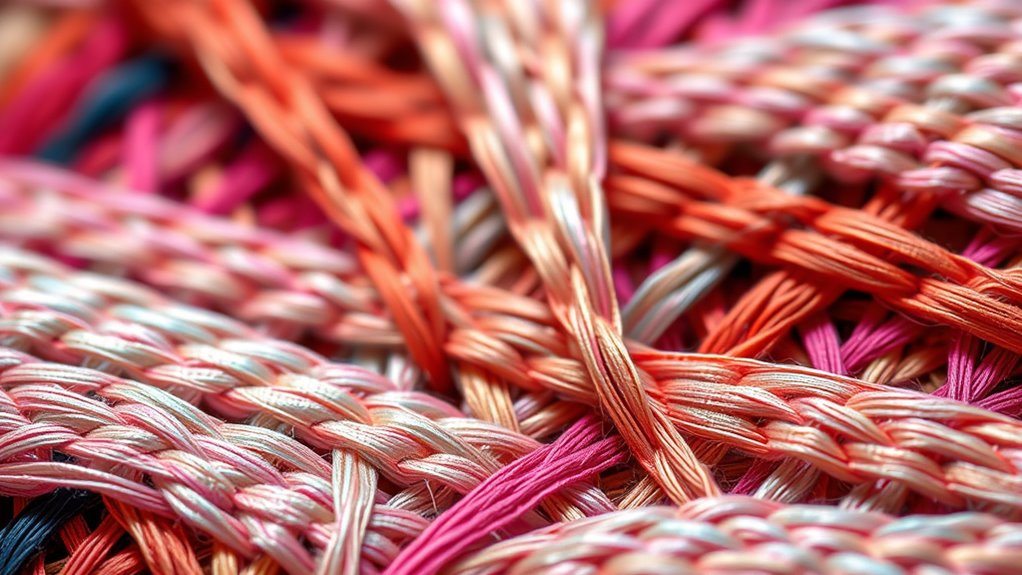
You can identify a weaving technique by closely observing the patterns and how the threads interlock. Pay attention to the materials and threading choices, as they reveal the weaver’s skill and intent. Examining the construction details helps you understand the piece’s structural integrity and craftsmanship. Additionally, understanding traditional weaving history can provide context for the techniques used and their cultural significance. Recognizing fiber types can also offer insights into the regional origins and the era in which the piece was created. Being aware of the environmental impacts associated with material choices can further deepen your appreciation of sustainable practices in weaving. Incorporating mindfulness into your observation process can enhance your ability to appreciate the subtle details and craftsmanship of each masterpiece. Moreover, studying the dyeing techniques used in the fibers can reveal information about traditional methods and regional aesthetics.
Weaving Pattern Recognition
Have you ever wondered how master weavers create such intricate and consistent patterns? It starts with recognizing the weaving pattern itself. Pay close attention to the color palette—how colors are arranged and repeated reveals the weaver’s intentional design choices. Notice the weaving symmetry, where mirrored or rotational patterns create balance and harmony. These elements help you identify signature techniques unique to a weaver’s style. By examining the structure of the weave—whether plain, twill, or complex geometric—you gain insight into their skill and method. Recognizing these patterns isn’t just about aesthetics; it’s about understanding the craftsmanship and thought process behind each masterpiece. Analyzing the weaving style can also reveal the influence of different weaving techniques and cultural origins. Over time, this pattern recognition becomes your key to appreciating and authenticating single-weaver creations.
Material and Threading Choices
Material and threading choices are essential to a weaving masterpiece, as they directly influence the fabric’s texture, durability, and visual effect. Your selection of fibers affects the fiber texture, which determines how the finished piece feels and looks—smooth, coarse, or lustrous. Fiber properties play a crucial role in shaping the final appearance and performance of the woven item. Understanding fiber characteristics helps in selecting the most suitable materials for specific artistic goals. Incorporating knowledge of payment security measures can also inform choices that ensure the longevity and integrity of the woven piece. Threading choices, including the order and method of threading the warp and weft, shape the fabric’s structure and stability. Consistent dye application is vital; uneven dye consistency can disrupt the visual harmony and highlight imperfections. Additionally, dyeing techniques can enhance the depth and richness of the colors used in the weaving process. By understanding how fiber properties interact with threading techniques, you can better appreciate the craftsmanship behind each signature piece. The type of dog names used can also influence the overall aesthetic and thematic coherence of the design. These choices reveal the artist’s skill and intention, ultimately defining the uniqueness of the weaving and its lasting impression.
Construction and Structural Details
The way fibers are woven together determines the overall structure and visual rhythm of a masterpiece. Your choice of weaving technique influences how the design appears and its durability. Notice the color palette used—subtle or bold hues that create harmony or contrast—and how they interact through the weave. Thread count plays a vital role; a higher count results in a finer, more detailed texture, while a lower count offers a more open, textured feel. Examine the construction pattern—whether it’s plain, twill, or complex weave—since this impacts both strength and aesthetic. Understanding these structural details helps you appreciate the craftsmanship behind each piece and reveals signature techniques that define a master’s unique style. Recognizing the construction pattern can also aid in assessing the piece’s longevity and quality.
Analyzing the Use of Color and Dyeing Methods
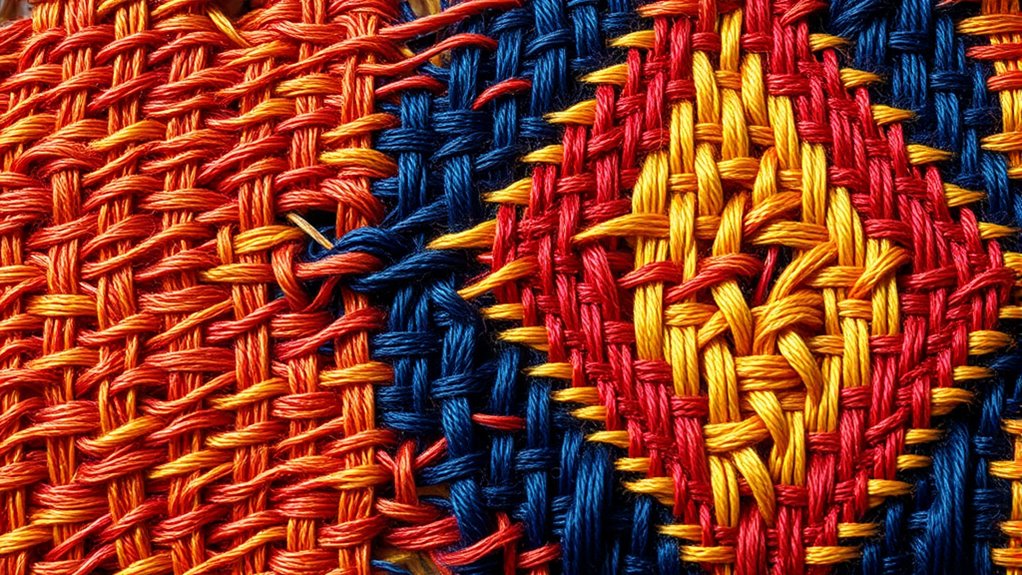
Color and dyeing methods in single-weaver masterpieces reveal a deep mastery of both tradition and innovation. By examining the dyeing history, you can trace how artisans developed techniques to achieve vibrant, lasting hues. These methods often involve natural dyes derived from plants, minerals, and insects, showcasing a rich cultural heritage. You’ll notice how color symbolism plays an essential role, with specific shades representing social status, spiritual beliefs, or regional identity. The skill lies not only in selecting dyes but also in controlling the dyeing process to produce consistent, nuanced tones. Additionally, advancements in predictive analytics have enabled artisans and historians to better understand and preserve traditional dyeing techniques, ensuring these cultural practices are passed down accurately. Modern research also explores natural dye extraction, revealing sustainable ways to maintain these age-old methods. As you analyze these pieces, pay attention to subtle variations and layered colors, which reflect the weaver’s expertise and the cultural significance embedded within each masterpiece.
Identifying Signature Textural Features
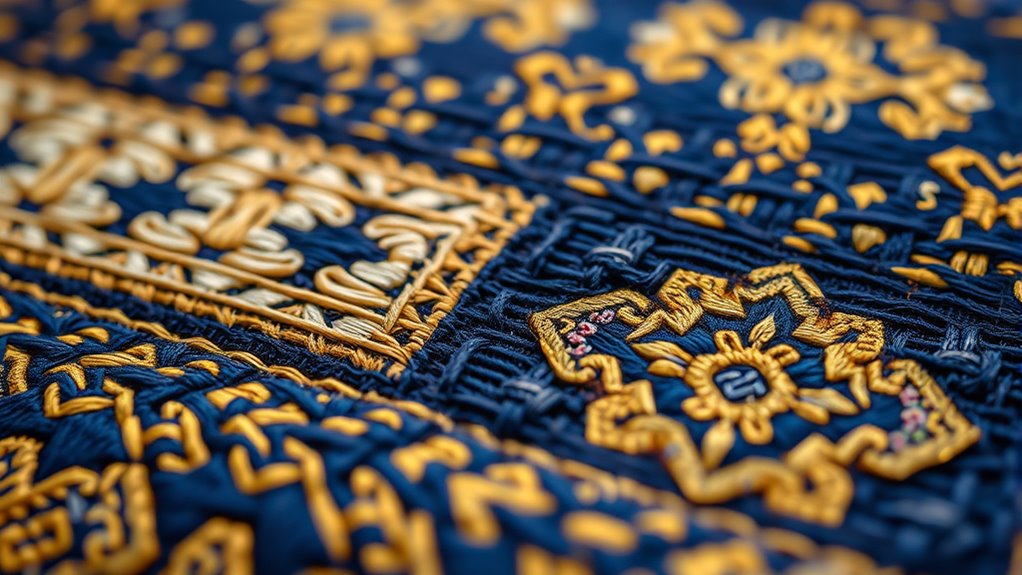
To truly appreciate single-weaver masterpieces, you need to recognize their signature textural features, which set them apart from other textiles. Fiber texture reveals the material’s uniqueness, whether it’s silky, coarse, or lustrous. Weave density indicates how tightly the threads are woven, affecting the fabric’s overall feel and visual impact. These features give each piece its distinct character. Use this table to compare key aspects:
| Feature | Description |
|---|---|
| Fiber Texture | The tactile quality of the material, such as smooth or rough |
| Weave Density | The closeness of the threads, influencing durability and appearance |
| Surface Texture | The visual and tactile surface pattern created by weaving techniques |
Recognizing these features helps you identify a masterful signature piece.
Investigating the Material and Fiber Choices
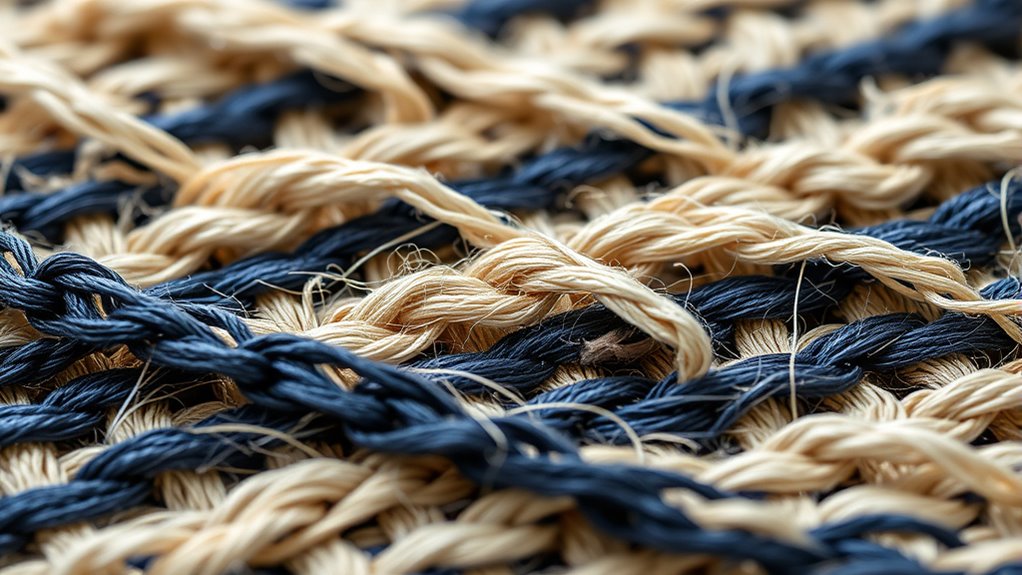
Have you ever wondered what materials and fibers artisans choose to create their masterful textiles? Examining their choices reveals much about their techniques and intentions. You’ll notice that dye techniques influence fiber selection—some artisans prefer natural dyes that require specific fibers, like wool or silk, for vibrant, lasting colors. Fiber durability also plays a role; artisans select sturdy fibers that withstand time and wear, ensuring their work remains intact. By analyzing the fiber types, you can identify whether the weaver prioritized softness, strength, or luster. These choices reflect both functional needs and aesthetic goals. Understanding the materials and fibers used offers insight into the artisan’s craftsmanship and the cultural context in which they worked, helping you appreciate the signature quality of their masterpieces.
Tracing the Cultural and Historical Influences
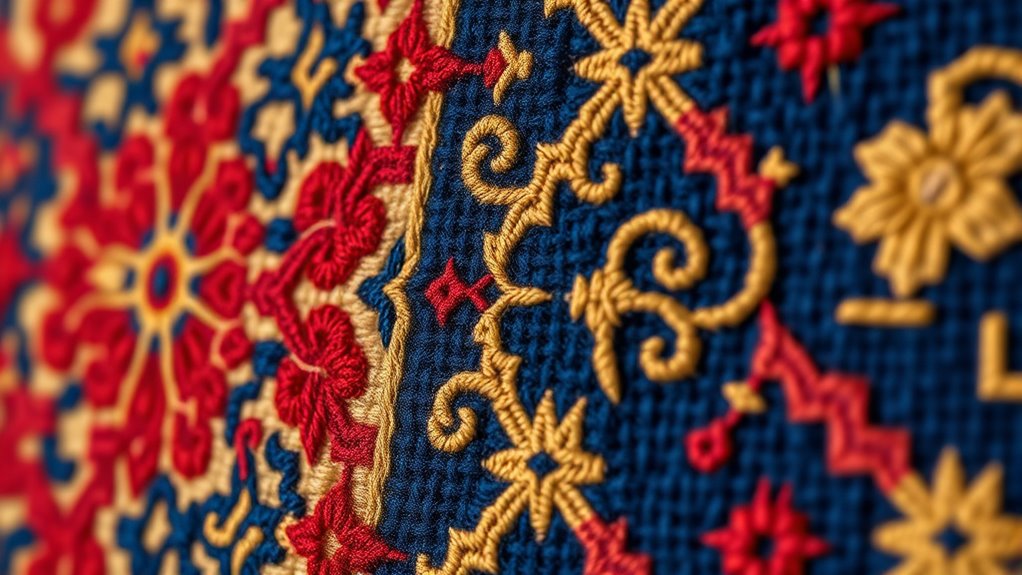
The materials and fibers artisans choose are deeply shaped by the cultural and historical contexts in which they create. You’ll notice how ceremonial significance influences design choices, with certain motifs or colors reserved for special rituals or events. Regional variations also play a pivotal role, reflecting local traditions, resources, and histories. For example, a piece from one area might incorporate specific dyes or weaving techniques unique to that region’s heritage. As you examine these masterpieces, you can trace how historical events, trade, and cultural exchanges shaped their styles. These influences help you understand the deeper meaning behind each piece, revealing how artisans express their identity, beliefs, and history through their craft.
Looking for Handcrafted Imperfections and Details
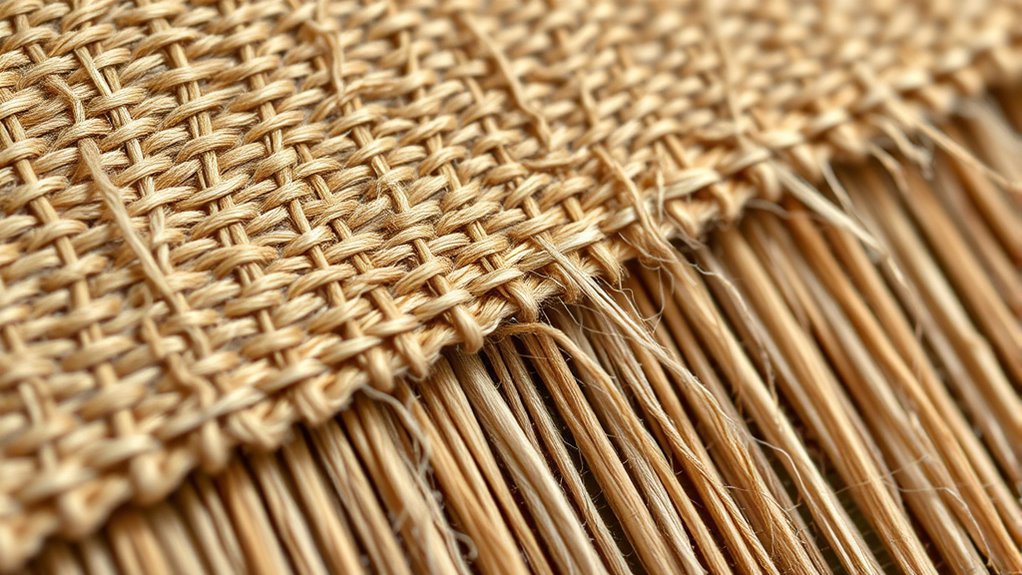
When examining handcrafted masterpieces, you’ll notice that small imperfections and subtle details are key to their charm. Look closely at fiber blending—uneven progressions or slight variations reveal the weaver’s manual touch. These irregularities often indicate a handcrafted process, not machine production. Pay attention to dye application too; inconsistent color layering or slight streaks highlight the artisan’s skill and intentional imperfections. These details add depth and character to the piece, making it unique. By observing how fibers are blended and how dyes are applied, you can distinguish genuine handcrafted works from mass-produced items. Embrace these imperfections as signs of authenticity, craftsmanship, and the artist’s personal expression. They’re what truly make a single-weaver masterpiece special and worth appreciating.
Assessing the Size, Shape, and Composition
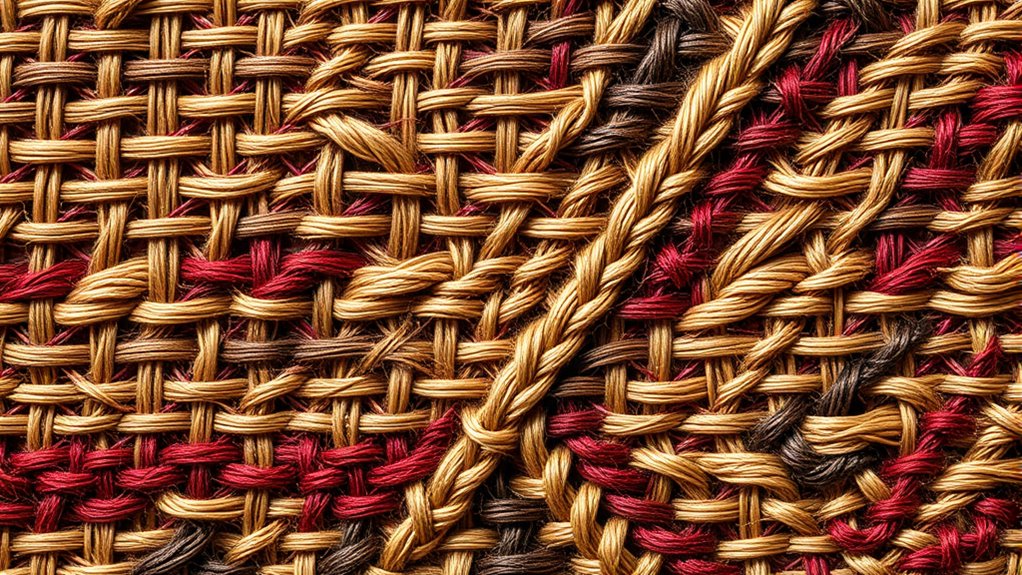
When examining a single-weaver masterpiece, you should start by evaluating its size and shape to understand its overall design. Next, analyze the material composition to identify the fibers used and their quality. Finally, evaluate the dimensions and form to appreciate the craftsmanship and how these elements come together in the finished piece.
Analyzing Material Composition
Have you ever wondered how master weavers determine the quality of their materials? It starts with fiber analysis, where you evaluate fiber strength, flexibility, and purity. You also consider material sourcing, ensuring fibers come from reputable suppliers to guarantee authenticity. To assist your assessment, here’s a quick comparison:
| Fiber Type | Typical Source | Key Quality Indicator |
|---|---|---|
| Silk | Mulberry trees | Luster and fineness |
| Wool | Sheep farms | Elasticity and softness |
| Cotton | Local farms | Fiber length and strength |
Evaluating Dimensions and Form
How do master weavers guarantee their textiles meet precise standards? They carefully evaluate dimensions and form by measuring fiber density, ensuring the fabric’s consistency. You check the warp and weft threads, as their tightness and alignment influence the overall shape and stability. Precise measurements of length, width, and thickness reveal the craftsmanship behind each piece. You also assess the balance of the textile—how the warp and weft interact to create a uniform surface. Variations in fiber density can affect the textile’s form, so you pay close attention to any irregularities. By examining these aspects, you verify that the piece maintains its intended size and shape, confirming the skill and intention of the weaver in producing a signature masterpiece.
Understanding the Weaver’s Personal Style and Symbolism
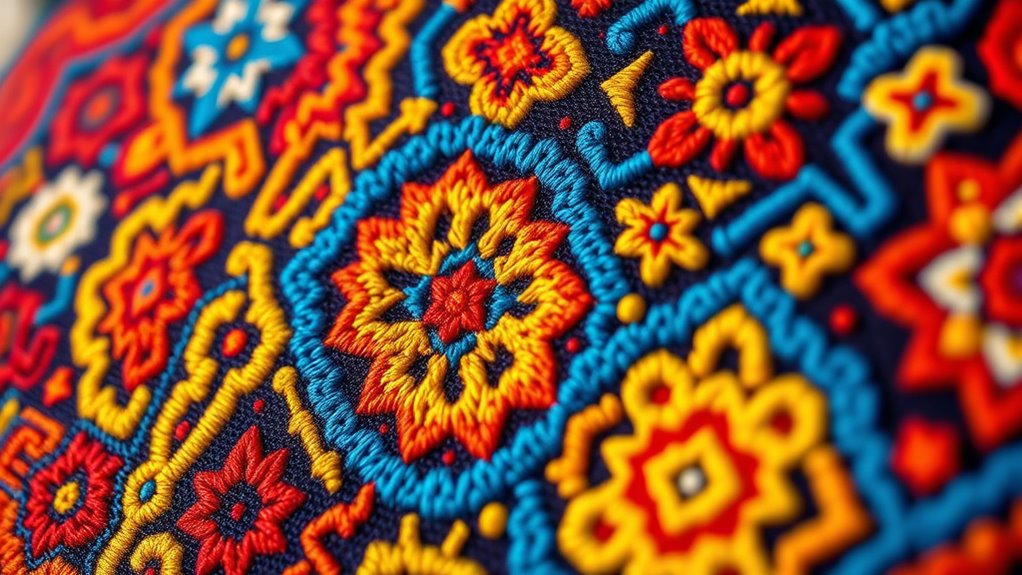
Understanding a weaver’s personal style and symbolism requires careful observation of their unique choices in color, pattern, and technique. Pay attention to their fiber dyeing methods, as these reveal preferences for natural or synthetic dyes, influencing mood and meaning. Note the patterns they select—geometric, abstract, or cultural motifs—that often carry symbolic significance. Additionally, examine the loom types used; different looms, such as tapestry or backstrap looms, can shape the overall aesthetic and craftsmanship. A weaver’s style reflects their cultural background, personal experiences, and artistic intentions. Recognizing these elements helps you interpret the deeper message behind each masterpiece, revealing the subtle language woven into every thread.
Authenticating Provenance and Artistic Signatures

You need reliable provenance documentation techniques to verify a masterpiece’s history and ownership. Recognizing authentic artist signatures is equally vital in confirming its origin. Together, these methods help guarantee the piece’s authenticity and value.
Provenance Documentation Techniques
Authenticating the provenance of a single-weaver masterpiece requires meticulous documentation techniques that verify its history and origin. You start by examining historical context records, such as catalogs, auction results, and previous ownership documentation, to trace its journey through time. Provenance records help establish authenticity and support claims about its significance. You should also analyze archival materials, like letters, receipts, or exhibition catalogs, to confirm connections to notable collections or events. These details directly influence its market value, making accurate provenance essential for valuation and sale. By systematically gathering and cross-referencing this evidence, you create a reliable provenance history that not only authenticates the piece but also enhances its desirability in the art market.
Recognizing Artist Signatures
Recognizing artist signatures is a essential step in verifying the authenticity of a single-weaver masterpiece. To assess signature authenticity, examine the signature’s style, placement, and consistency with known examples from the artist. Authentic signatures often reflect the artist’s unique handwriting or stamp, making them a key indicator of provenance. Keep in mind that for highly reputable artists, their signatures tend to be distinctive and well-documented, adding confidence to your identification. Be cautious of forgeries or altered signatures that may look convincing but lack subtle details. Your evaluation should combine signature analysis with provenance records and expert insights. By carefully scrutinizing these elements, you can better determine the artist’s reputation and verify the piece’s authenticity, protecting your investment and preserving the artwork’s historical value.
Frequently Asked Questions
How Do Signature Pieces Influence the Overall Value of a Weaving Collection?
Signature pieces markedly boost your weaving collection’s value because they embody unique weaving symbolism and craftsmanship. These pieces often reflect the weaver’s distinct style, making them highly sought after by collectors. Your motivation to acquire such works increases their worth, as they represent cultural or artistic significance. As a result, signature pieces elevate the collection’s prestige and monetary value, drawing interest from enthusiasts who appreciate the artistic story behind each weaving.
Are There Specific Signs That Distinguish Authentic Masterpieces From Reproductions?
Think of authentic masterpieces as rare gems shining through a fog. You can spot them by authenticity markers like consistent, intricate details and vibrant, well-preserved colors. Artistic techniques such as unique weaving patterns or signature stitches also set genuine works apart from reproductions. When you examine these signs carefully, you’re effectively unmasking the true artistry behind each piece, ensuring you appreciate the craftsmanship that’s truly one of a kind.
Can a Single Piece Reveal the Entire Cultural Background of Its Maker?
You can often tell a lot about a maker’s cultural background through a single piece, especially by examining cultural symbolism and artistic techniques. These elements reflect their traditions, beliefs, and regional influences. By analyzing motifs, materials, and craftsmanship, you gain insights into their heritage. While one piece can’t tell the entire story, it offers a meaningful glimpse into their cultural identity, revealing influences that shaped their artistic expression.
What Role Does Provenance Play in Verifying a Weaving’s Significance?
Provenance plays a key role in verifying a weaving’s significance because it provides authenticity markers and detailed provenance documentation. When you examine a piece’s history, you can better assess its cultural value and origins. This context helps confirm the craftsmanship, origin, and authenticity, ensuring you’re appreciating a genuine artifact. Without clear provenance, it’s harder to determine a weaving’s true significance, making provenance essential in establishing its cultural and artistic importance.
How Can Collectors Differentiate Between a Master’S Style and Regional Variations?
Imagine unraveling a tapestry of mastery, where each thread whispers secrets of its creator. To differentiate a master’s style from regional variations, you look for pattern consistency that echoes their unique touch. Regional motifs often reveal local stories or traditions, while a master’s signature lies in subtle details and refined execution. By observing these nuances, you can trace the artist’s hand amidst the vibrant culture’s fabric, revealing true mastery.
Conclusion
By paying attention to these signature elements, you can truly see the artist’s fingerprint in every weave. Trust your eye to spot those subtle details that set a piece apart, like a needle in a haystack. Remember, it’s often the little imperfections and unique motifs that tell the real story. When you start recognizing these signs, you’ll find yourself uncovering hidden treasures that speak volumes about the weaver’s skill and vision.



